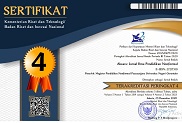Noun Phrase In Minang Language
Abstract
Keywords
Full Text:
PDFReferences
Adedoyin, O. B. (2020). Qualitative Research Methods. Principles of Social Psychiatry: Second Edition, 77-87. https://doi.org/10.1002/9780470684214.ch7
Cropley, A. (2019). Introduction to qualitative research methods. In A research handbook for patient and public involvement researchers. https://doi.org/10.7765/9781526136527.00012
Dikken, M. den. (2013). Generative Syntax. In International Encyclopedia of the Social & Behavioral Sciences. Cambridge University Press. https://doi.org/10.1016/b0-08-043076-7/02951-x
Fukui, N. (2018). 12 Phrase Structure. 2018, 3, 374-406.
JapenSarage. (2014). The Relationship Between Noun Phrase And Verb Phrase. ADJES (Ahmad Dahlan Journal of English Studies), 1(1-2), 49-58. https://doi.org/10.26555/adjes.v1i1-2.1687
Jufrizal, Zaim, M., & Ardi, H. (2015). STRUKTUR GRAMATIKAL DAN BUDAYA BERBAHASA : Data dan Informasi Bahasa Minangkabau.
Junaid, J. (2018). a Syntactic Analysis of the English Noun Phrase (a Study A Syntactic Analysis of The English Noun Phrase ( A Study At the Fifth Semester of English Department Faculty of Teacher Training and Education University of Muhammadiyah Makassar). Perspektif: Jurnal Pengembangan Sumber Daya Insani, 3(1), 317-326.
Kornai, A., & Pullum, G. K. (1990). The X-bar theory of phrase structure. Language, 66(1), 24-50. https://doi.org/10.1353/lan.1990.0015
Kurniawati, W. (2020). Struktur Frasa, Klausa, Dan Kalimat Bahasa Talondo. Sirok Bastra, 8(1), 109-122. https://doi.org/10.37671/sb.v8i1.207
Lindawati. (2015). Bahasa Minangkabau. Minangkabau Press.
Mulyadi. (2008). Struktur Frasa Adjektival dalam Bahasa Indonesia. Jurnal Ilmiah Bahasa Dan Sastra, IV(1), 22-30. http://badanbahasa.kemdikbud.go.id/lamanbahasa/produk/102
R, M. (1985). Struktur Frasa Bahasa Kodeoha. Animal Reproduction Science, 9, 95-98.
Umiyati, M., & Kosmas, J. (2010). THE INFLECTIONAL PHRASE IN MANGGARAI LANGUAGE. 147-152.
Wittaningsih, A. (2018). English Passive Voice : An X-Bar Theory Analysis. 4(2).
DOI: http://dx.doi.org/10.37905/aksara.7.3.1077-1086.2021
Refbacks
- There are currently no refbacks.
Copyright (c) 2021 Aksara: Jurnal Ilmu Pendidikan Nonformal

This work is licensed under a Creative Commons Attribution-ShareAlike 4.0 International License.
Publisher:
Magister Pendidikan Nonformal Pascasarjana Universitas Negeri Gorontalo
Jl. Soedirman No. 06 Gorontalo 96128 e-mail: jurnalaksara@ung.ac.id
http://ejurnal.pps.ung.ac.id







